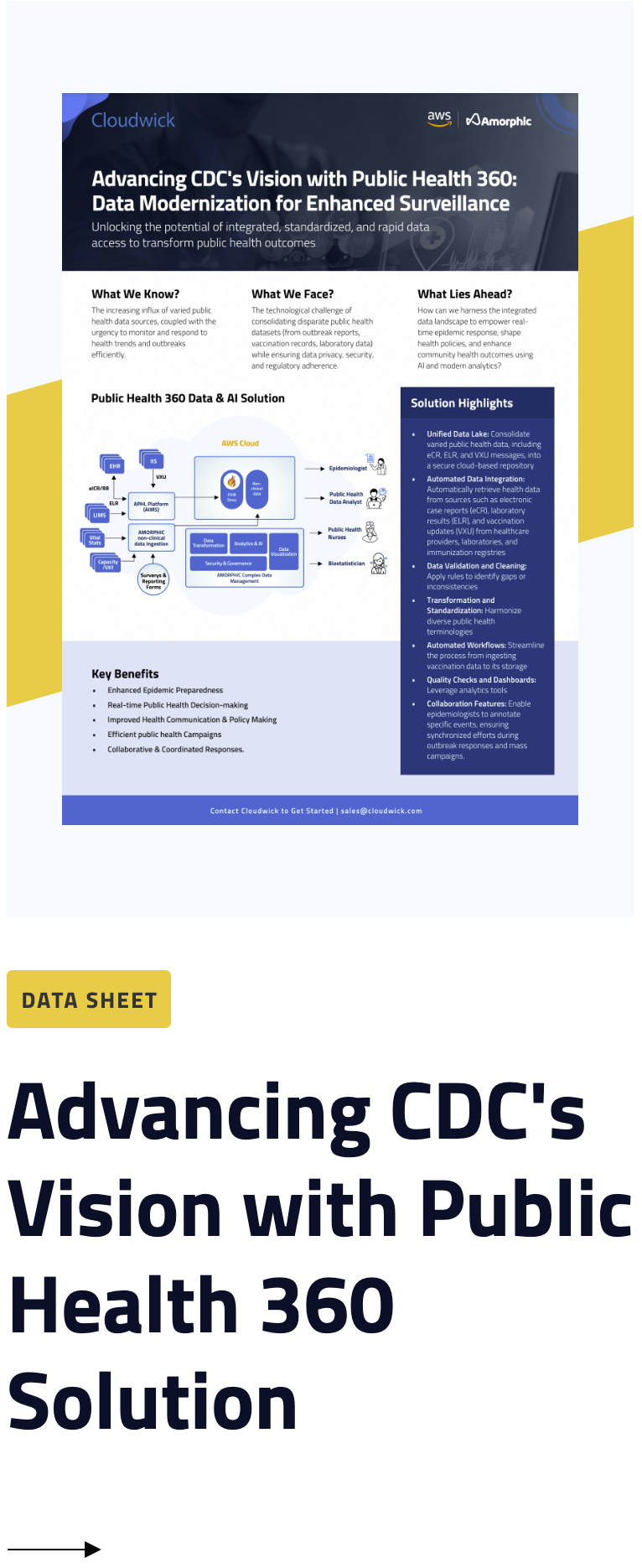Amorphic Public Health 360 Solution FAQs
Epidemiologist (EPI) / Surveillance Manager
Data Modernization Director
Public Health 360 is intricately designed to align with the CDC's DMI by offering a comprehensive, cloud-based data infrastructure that emphasizes real-time analytics, interoperability, and secure data sharing—core principles championed by the DMI.
Public Health Informatician
Public Health CIO/IT
How does the platform address potential IT challenges such as downtime, data redundancy, and backup?
Throughout your data modernization process, expect full support and regular updates from the Public Health 360 solution. It is continuously evolving, frequently incorporating AWS services tailored for the public sector. Recent integrations include AWS Healthlake, AWS Imaging, and Sequencing services. These updates are rolled out quarterly, ensuring smooth adoption for your team.
The platform emphasizes transparent communication. The developers share roadmaps and work closely with your team to align platform upgrades with your data objectives. This ongoing support and transparency underscore their commitment to elevating your data modernization initiatives with the most recent solutions.
Investment Benefits
According to the CDC, Epidemiologists (EPIs), typically spend 80% of their time cleaning data and only 20% analyzing it. With Public Health 360, this ratio shifts dramatically, allowing only 20% for cleaning and a significant 80% for analysis. This translates to a reclaimed value of $63,599.68 annually for an EPI earning $106,000.
In essence, adopting Amorphic is akin to gaining an extra part-time analyst, freeing up over 1,200 hours each year for enhanced data insights.
.png)
Joshua Couturier
Meet Joshua, a dedicated and results-driven professional with a fervent passion for leveraging data-driven insights to foster innovation. With a proven track record in implementing cutting-edge solutions, Joshua is committed to transforming healthcare practices through the strategic use of data and technology. His expertise is crafting transformative strategies that elevate industry standards and drive positive change. Book a meeting with Joshua and discover how his commitment to innovation can shape the future of your healthcare initiatives.
Schedule a Meeting%20(2).png)
.png?width=1200&length=1200&name=Copy%20of%20Amorphic_The%20Public%20Health%20Data%20Solution%20LP%20Banner%20(1).png)
.png?width=1200&length=1200&name=Copy%20of%20Amorphic_The%20Public%20Health%20Data%20Solution%20LP%20Banner%20(2).png)
.png?width=1200&length=1200&name=Copy%20of%20Amorphic_The%20Public%20Health%20Data%20Solution%20LP%20Banner%20(3).png)
.png?width=1200&length=1200&name=Copy%20of%20Amorphic_The%20Public%20Health%20Data%20Solution%20LP%20Banner%20(4).png)
.png?width=1200&length=1200&name=Copy%20of%20Amorphic_The%20Public%20Health%20Data%20Solution%20LP%20Banner%20(9).png)
